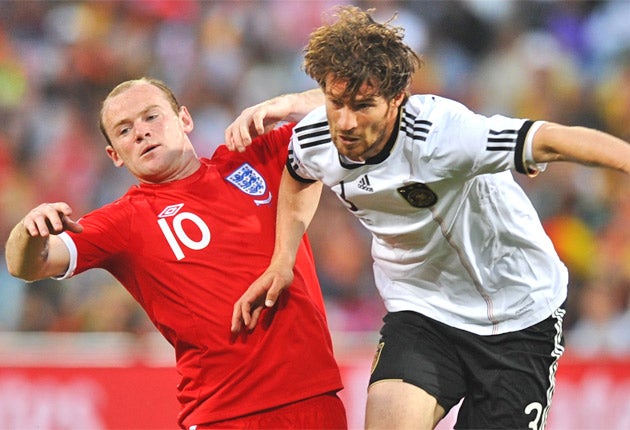Capello finally admits 4-4-2 belongs in dark days and that 4-3-3 is future
Jack Pitt-Brooke explains the thinking behind England's tactical overhaul and sees a strong German influence in a more fluid set-up

Your support helps us to tell the story
From reproductive rights to climate change to Big Tech, The Independent is on the ground when the story is developing. Whether it's investigating the financials of Elon Musk's pro-Trump PAC or producing our latest documentary, 'The A Word', which shines a light on the American women fighting for reproductive rights, we know how important it is to parse out the facts from the messaging.
At such a critical moment in US history, we need reporters on the ground. Your donation allows us to keep sending journalists to speak to both sides of the story.
The Independent is trusted by Americans across the entire political spectrum. And unlike many other quality news outlets, we choose not to lock Americans out of our reporting and analysis with paywalls. We believe quality journalism should be available to everyone, paid for by those who can afford it.
Your support makes all the difference.England's evisceration by Germany in Bloemfontein last summer was as powerful a lesson in the importance of team play as any in recent years. Fabio Capello strode into the tie with a 4-4-2 system, pairing Jermain Defoe and Wayne Rooney up front. Behind them lay a flat midfield four with few obvious passing angles, little imagination and even less pace. There was no one to link with Rooney and Defoe up front and the forwards were desperately isolated, starved of both helpful service or even the proximity of useful team-mates. More damagingly, there was a savannah of space behind the English midfield and in front of their defence. Gareth Barry was only nominally responsible for defensive patrols but, even when fully fit, which he was not, he does not have the mobility or the ruthlessness of a Nigel de Jong or a Gennaro Gattuso. Barry and Frank Lampard were outnumbered and outrun in central midfield. The Germans teased and dragged them around the pitch, and stormed through the space behind them, scoring four excellent goals.
Germany, in stark contrast, were a model of a modern, coherent, well-integrated team. Playing 4-2-3-1, they left no open spaces like England did, and none of their players was isolated as they overcame the absence of their captain and senior player Michael Ballack to reach the semi-finals. In doing so, Germany made it clear they were prioritising the team over individuals, the opposite of England, who seemed to suffer their usual panic over absent players. Sami Khedira and Bastian Schweinsteiger sat in front of the back four but had the maturity to pick their moments to break forward. Then a band of three linked the two holders to the striker, playing in the space between England's defence and midfield. An extra midfielder meant they covered more of the pitch, and had better passing angles than England did in their rigid, right-angled system. The security of the defensive two allowed their wide players to attack more, and Thomas Müller and Lukas Podolski scored three goals between them against England, and seven in the tournament.
For England's first competitive international this year, against Wales on Saturday, Capello adopted a new approach. The 4-4-2 was rejected in favour of a 4-3-3, and the players were shown videos of Barcelona, the masters of that system, for instruction. The extra man in midfield, in this case Scott Parker, prevented the exposure of England's defence and also released Jack Wilshere and Lampard to play further up the pitch. Having three rather than two central midfielders provided more passing options. Capello told the players to press higher up the pitch, and they were enabled to do so by both Parker's presence and also a front three. Rooney and Ashley Young played higher up the pitch than wingers would in a 4-4-2, thereby allowing them to put more pressure on Welsh players in possession. Young was a constant threat in his advanced role as part of a front three, winning the penalty for the first goal and making the run in behind and the cross for England's second. Rooney is no stranger to wide duties at Manchester United and was accomplished in his left-wing role.
Join our commenting forum
Join thought-provoking conversations, follow other Independent readers and see their replies
Comments